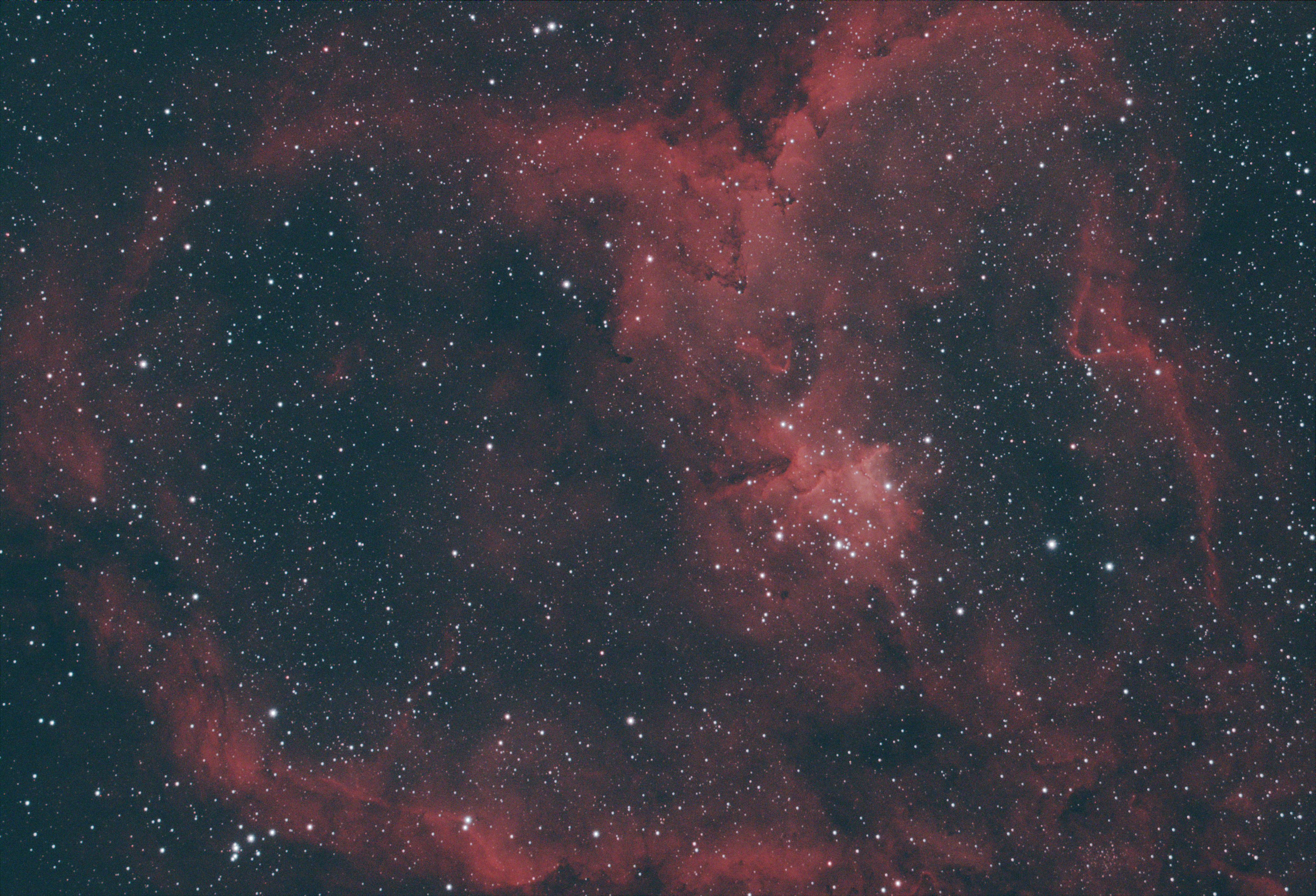The Heart Nebula: IC 1805

|
| The Heart Nebula: Taken under Michigan skies, December 13th, 2021 |
Discovered by William Hershel in 1787, IC 1805 was coined the Heart Nebula for having a structure that sort of resembles that of the human heart. The Heart Nebula is an emission nebula which means it's a cloudy structure of ionized gasses that emits its own light. The wavelength (or color) of light that nebulae emit at will tell you exactly what gas the cloud is composed of. The Heart Nebula emits primarily at a specific red wavelength of light: 656.3 nanometers. This wavelength of red tells us that the nebula is composed of ionized Hydrogen gas labeled Hydrogen-Alpha.
Ionized hydrogen can emit at four different colors in the visible spectrum: violet, blue, light-blue and red. The hydrogen atom will release a photon at one of these wavelengths when its electron drops orbits. The photon's wavelength depends entirely on the starting and ending orbital state of the transitioning electron of the hydrogen atom.

|
|
The Hydrogen Emission Spectral Lines |
Light Pollution and Sky Glow
Let's think of a deep-space object in the night sky as a type of signal we are trying to record. The subtleties of the nebula's structure we would like to focus on are actually coupled with other signals we don't want to focus on. We call these other signals 'noise'. There is external signal noise that comes from outside the camera's electronics and internal signal noise that comes from features of the electronics itself but I'll only talk about the external sources of signal noise.
One of two of the main sources of external noise is light pollution which is any light emitted from the ground here on Earth that ends up scattering in the atmosphere. In some regions this noise has been restricted to a few narrow wavelengths of light thanks to regulations requiring the use of sodium-vapor lamps for general street and parking lot illumination. This allows astronomers to leverage a light pollution filter to reject a specific wavelength of light in order to counter a portion of light pollution.
However, most areas lack these regulations, especially with the widespread adoption of LED lighting. It is way more economical to use LED lighting and even saves a ton on energy consumption. The tradeoff of LED lighting is a nastier spread of light pollution that is next to impossible to filter out without distorting the original signal of the deep-sky target itself.
Another source of noise is the sun itself. It may sound strange that the sun has any role in our view at night and this is because it does so with the help of the moon and our atmosphere. When the moon is out at night, it is reflecting some amount of sun light back to Earth. This light ends up scattering in Earth's atmosphere adding a sky-glow signal. The more lit up the moon is, the more intense the sky-glow becomes. This light is full-spectrum sunlight, meaning there is no way to really filter this out without distorting the signal of the target you are trying to capture.
Narrowband Imaging Filters
Some deep-sky objects such as galaxies and star clusters are considered broadband targets. This means that to capture their true color you want to record all visible wavelengths (as leaving any wavelength out will end up distorting the original signal by leaving out true details). Deep-sky objects such as nebulae on the other hand, are considered narrow-band targets. This is because the light they emit is unique to the few gasses they are made up of and thus emit narrowly at specific wavelengths of light. A Narrowband imaging filter is designed only to allow a very small portion of the electromagnetic spectrum and block the rest. This allows for the rejection of most signal noise whether originating from street-lights or from the sun reflecting off the moon.
The image of the Heart Nebula here was taken during a 78% illuminated moon. This much noise from the moon will wash out any broadband targets I'm trying to record and that's without even considering the frustrations of light pollution washing the signal out. I actually took this image using a dual-pass narrow band imaging filter that is designed to only let photons through that are generally emitted by ionized gasses such as Hydrogen and Oxygen. This filter greatly improves the quality of the nebula but it also sacrifices the color-accuracy of all the stars in the image. Since my focus was to record the nebula itself, I'm ok with this tradeoff. However, I've seen many techniques to record both star data end nebula separately and then recombine them in the final image.
Comments
Post a Comment